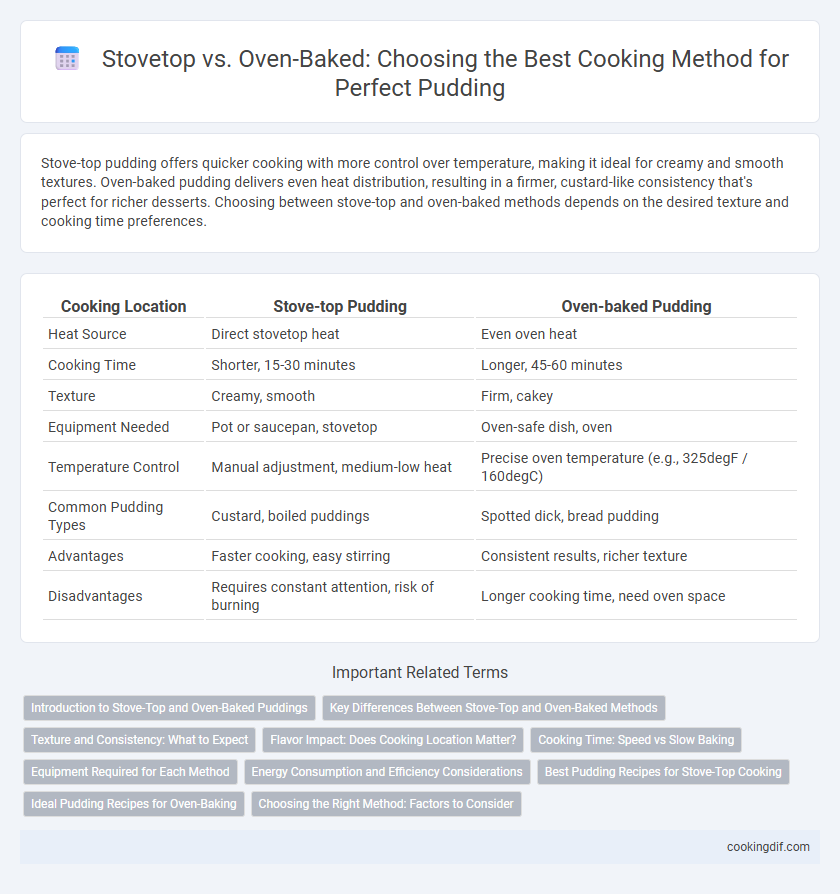Stove-top pudding offers quicker cooking with more control over temperature, making it ideal for creamy and smooth textures. Oven-baked pudding delivers even heat distribution, resulting in a firmer, custard-like consistency that's perfect for richer desserts. Choosing between stove-top and oven-baked methods depends on the desired texture and cooking time preferences.
Table of Comparison
| Cooking Location | Stove-top Pudding | Oven-baked Pudding |
|---|---|---|
| Heat Source | Direct stovetop heat | Even oven heat |
| Cooking Time | Shorter, 15-30 minutes | Longer, 45-60 minutes |
| Texture | Creamy, smooth | Firm, cakey |
| Equipment Needed | Pot or saucepan, stovetop | Oven-safe dish, oven |
| Temperature Control | Manual adjustment, medium-low heat | Precise oven temperature (e.g., 325degF / 160degC) |
| Common Pudding Types | Custard, boiled puddings | Spotted dick, bread pudding |
| Advantages | Faster cooking, easy stirring | Consistent results, richer texture |
| Disadvantages | Requires constant attention, risk of burning | Longer cooking time, need oven space |
Introduction to Stove-Top and Oven-Baked Puddings
Stove-top puddings cook gently over simmering water or direct heat, allowing for smooth, creamy textures ideal for custards and traditional rice puddings. Oven-baked puddings use consistent, dry heat within a water bath or baking dish, resulting in denser, richly flavored desserts like bread pudding or Yorkshire pudding. Each method influences moisture retention and final texture, shaping the pudding's unique taste profile and presentation.
Key Differences Between Stove-Top and Oven-Baked Methods
Stove-top pudding involves constant stirring and precise temperature control, resulting in a creamier texture and faster cooking time. Oven-baked pudding, often cooked in a water bath, provides a firmer, custard-like consistency with even heat distribution, but requires longer cooking periods. Both methods differ significantly in heat application and texture outcome, influencing the final pudding quality.
Texture and Consistency: What to Expect
Stove-top pudding typically yields a creamier and smoother texture due to constant stirring and controlled heat, preventing lumps and ensuring even thickening. Oven-baked pudding develops a denser, custard-like consistency with a slight crust on top, thanks to the slow, even heat that allows gradual setting without frequent disturbance. Choosing between stove-top and oven-baked methods impacts the pudding's texture significantly, with stove-top favoring softness and oven-baked favoring firmness and structure.
Flavor Impact: Does Cooking Location Matter?
Stove-top pudding often delivers a creamier texture with a more intense, caramelized flavor due to direct heat control, enhancing the custard's richness. Oven-baked pudding tends to cook more evenly, producing a denser consistency and subtle, baked notes that deepen the overall taste. The choice between stove-top and oven-baked methods significantly influences flavor development and texture, making cooking location a key factor in pudding preparation.
Cooking Time: Speed vs Slow Baking
Stove-top pudding typically cooks faster, often within 15 to 25 minutes, using direct heat to achieve creamy consistency efficiently. Oven-baked pudding requires longer cooking times, usually between 45 minutes to an hour, allowing slow, even heat distribution that enhances depth of flavor and texture. Choosing stove-top speeds up meal prep, while oven-baking fosters richer taste through gradual cooking.
Equipment Required for Each Method
Stove-top pudding requires a heavy-bottomed saucepan or double boiler to ensure even heat distribution and prevent scorching, along with a whisk or spatula for constant stirring. Oven-baked pudding demands a heatproof baking dish or pudding basin and a roasting pan for the water bath to provide gentle, consistent heat. Proper lids or foil covers are essential for oven-baked methods to retain moisture and achieve the desired texture.
Energy Consumption and Efficiency Considerations
Stove-top pudding cooking generally consumes less energy due to shorter cooking times and direct heat application, making it more efficient for small batches. Oven-baked pudding often requires longer cooking durations and preheating, leading to higher overall energy usage, but it ensures even heat distribution ideal for consistent texture in larger portions. Choosing between stove-top and oven-baked methods depends on balancing energy consumption with desired pudding quality and portion size.
Best Pudding Recipes for Stove-Top Cooking
Stove-top pudding recipes often deliver creamier textures and faster cooking times compared to oven-baked methods, making them ideal for recipes like traditional bread pudding and rice pudding. These recipes typically use direct heat and constant stirring, preventing lumps and ensuring smooth consistency. Popular stove-top pudding dishes include classic chocolate pudding, butterscotch pudding, and tapioca pudding, prized for their rich flavors and quick preparation.
Ideal Pudding Recipes for Oven-Baking
Oven-baked pudding recipes deliver a consistent, even heat ideal for custards and bread puddings, promoting creamy textures and rich flavors through slow, gentle cooking. Unlike stove-top methods that require constant attention to prevent scorching, oven-baking allows for hands-off preparation with a controlled water bath or slow roasting in a covered dish. Classic oven-baked puddings like Yorkshire pudding and sticky toffee pudding showcase the benefits of steady oven heat in achieving light, fluffy, and moist results.
Choosing the Right Method: Factors to Consider
Stove-top pudding offers precise temperature control and quicker cooking, ideal for delicate custards or recipes requiring constant stirring to prevent curdling. Oven-baked pudding delivers even, gentle heat that promotes uniform setting and richer texture, especially suited for dense or layered desserts. Consider factors such as desired texture, recipe complexity, and available kitchen equipment when selecting the optimal cooking method for your pudding.
Stove-top vs oven-baked for cooking location Infographic

 cookingdif.com
cookingdif.com